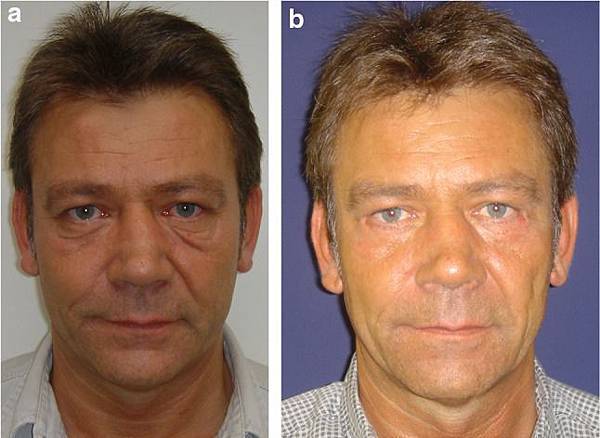Vertical Subperiosteal Mid-face-lift for Treatment of Malar Festoons(1)
Aesthetic Plast Surg. Aug 2011; 35(4): 522–529.
Johannes Franz Hoenig,1,2 Daniel Knutti,1,2 and Antonio de la Fuente1,2
1University Hospital and Medical School of Goettingen, Robert-Koch-Street 40, 37075 Goettingen, Germany
2Department of Plastic and Aesthetic Surgery, Paracelsus Clinic, Hannover, Germany
Johannes Franz Hoenig, Email: info@professor-hoenig.de.
Published online Mar 17, 2011. doi: 10.1007/s00266-010-9650-3
PMCID: PMC3146709
(http://www.ncbi.nlm.nih.gov/pmc/articles/PMC3146709/)
(http://openi.nlm.nih.gov/detailedresult.php?img=3146709_266_2010_9650_Fig1_HTML&req=4)
Affiliation :
University Hospital and Medical School of Goettingen, Robert-Koch-Street 40, 37075 Goettingen, Germany. info@professor-hoenig.de
Keywords : Festoons, Malar membrane, Vertical subperiosteal midface lift, Malar mounds, Blepharoplasty
ABSTRACT
Background :
Malar mounds may be accentuated by chronic lid edema, with the development from malar Edema to malar Mounds and finally to malar Festoons. Because standard techniques do not seem effective and not specifically proposed for the treatment of malar festoons, subperiosteal vertical upper-midface lift associated with lower blepharoplasty overcomes these shortcomings.
Methods :
Twelve patients (3 males and 9 females, age = 47 ± 6 years) underwent Video-assisted endoscopic subperiosteal vertical upper-midface lift(SUM-lift)in conjunction with a lower blepharoplasty between 2006 and 2007 for treatment of malar festoons. This includes simultaneous lower blepharoplasties and video-assisted transtemporal subperiosteal and sub-SMAS tissue release.
Results :
All patients healed uneventfully without any major postoperative problems. The surgical outcome was evaluated according to the analysis of photographs obtained before and after surgery and the analysis of pre- and postoperative measurements. The technique we used(SUM-lift)achieved a significant rejuvenation of the midface and the malar festoons.
Conclusion :
Subperiosteal vertical midface lift resuspends and redrapes the facial network that originates at the level of the orbital rim. It seems to improve the permeability characteristics of the malar septum in the treatment of malar festoons and malar mounds by freeing the cheek tissue from underlying bone and redraping the malar septum. It is a reliable technique to improve malar mounds, palpebral bags, or festoons.
Introduction
During the aging process three variations of the infraorbital area may appear. Malar mounds, Palpebral bags, or Festoons (Fig. 1; see also Fig.
17a). Festoons are developmental Attenuation of the orbicularis
oculi muscle with Laxity of the attachments between the orbicularis and the deep fascia [1]. The orbicularis oculi muscle progressively sags until folds of muscle are suspended across the lower lid. Malar mounds in contrast are discrete soft tissue convexities that bulge directly outward from the malar prominence [2, 3]. They retain a relatively stable shape during usual facial movements, but can be worsened with smiling. Palpebral bags or Baggy eyelids develop at an early age and are also known as Herniated intraorbital fat [1]. They are the result of Intraorbital fat bulging outward against an attenuated or weak orbital septum of the upper or lower eyelid. Some of these changes cause functional and aesthetic problems for which surgical correction is a gratifying procedure, although surgical treatment of festoons, mostly seen in older patients who have lax supporting structures [1] in the preseptal area, orbital area, and the jugal region of the lower lid, is known to be difficult [1–5].

Fig. 1
1 = Festoons ; 2 = malar mounds; 3 = palpebral bags

Fig. 17
a. Preoperative view of a 48-year-old patient with marked malar festoons, redundant eyelid skin, and deep nasojugal grooves.
b. Postoperative view (14 months) after he underwent a vertical upper-midface lift (SUM-lift); the malar festoons are improved ...
Various surgical techniques have been used to treat malar bags and muscle festoons for the lower eyelid, taking into account its various etiologies. Pessa and Garza [2], who analyzed malar mounds and malar edema, found that the Malar septum acts as a relatively impermeable barrier that allows tissue edema to accumulate above its cutaneous insertion. Following their studies, this septum defines the lower “boundary” of several clinical entities, e.g., Malar mounds, Malar edema, Malar festoons. Therefore, malar mounds may be accentuated by chronic lid edema which may imply a time course in the progressive development from Malar edema to Malar mound and at least to Malar festoons [2].
Knowing that standard lower blepharoplasties cannot correct malar loops with muscle pouches, nor the sagging of the lower orbicular muscles (ptosis), and that standard techniques do not seem effective and are not specifically proposed for the treatment of malar festoons, subperiosteal vertical upper-midface lift associated with lower blepharoplasty overcomes these shortcomings. In this article we share our experiences with our technique.



 留言列表
留言列表
